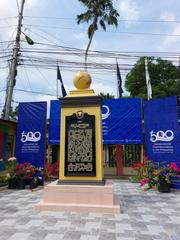Visiting Taluksangay Mosque in Zamboanga City: Hours, Tickets, and Tips
Publication Date: 01/08/2024
Introduction to Taluksangay Mosque
The Taluksangay Mosque, situated in the coastal village of Taluksangay in Zamboanga City, Philippines, stands as the oldest mosque in Western Mindanao. Constructed in 1885 by Hadji Abdullah Maas Nuno, this architectural marvel has become a significant symbol of the Islamic heritage in the region (Traveling Up). Renowned for its distinctive red domes and traditional Islamic motifs, the mosque attracts visitors from around the world, eager to explore its rich history and cultural significance. This comprehensive guide aims to provide detailed insights into the Taluksangay Mosque’s history, architectural features, visitor information, cultural impact, and preservation efforts. Whether you are a history enthusiast, cultural explorer, or a curious traveler, this guide will equip you with all the necessary information to make your visit to the Taluksangay Mosque memorable and respectful.
Contents Overview
- Introduction
- History of Taluksangay Mosque
- Architectural Features
- Visitor Information
- Cultural Impact
- Preservation and Recognition
- Nearby Attractions
- Frequently Asked Questions (FAQ)
- Conclusion
History of Taluksangay Mosque
Origins and Construction
The Taluksangay Mosque was constructed in 1885 by Hadji Abdullah Maas Nuno, a prominent figure in the local Muslim community. This mosque marked a significant milestone in the propagation of Islam in the Zamboanga Peninsula. With its striking red domes, the mosque has become a distinctive feature symbolizing its historical and cultural importance (Traveling Up).
Historical Significance
Since its inception, the Taluksangay Mosque has attracted Muslim religious missionaries from countries such as Saudi Arabia, India, Malaysia, Indonesia, and Borneo. These missionaries have helped spread Islamic teachings and practices in the region, making the mosque a focal point for religious and cultural exchange. Its location on the banks of a river in the outskirts of Zamboanga City also makes it a significant landmark for travelers and pilgrims of different faiths (Traveling Up).
Architectural Features
The mosque is renowned for its unique architectural design, characterized by its red domes and traditional Islamic motifs. The structure reflects the architectural influences of various Muslim communities that have visited and contributed to its development over the years. The design not only serves religious purposes but also stands as a testament to the rich cultural heritage of the Muslim community in Zamboanga City.
Visitor Information
Visiting Hours and Tickets
The Taluksangay Mosque is open to visitors throughout the year. While there is no entrance fee, donations are highly appreciated to support the maintenance and preservation of the mosque. Visitors are encouraged to dress modestly and respect the sanctity of the mosque during their visit.
Getting There
The mosque is located in the coastal village of Taluksangay, approximately 19 kilometers from the city center of Zamboanga City. Visitors can take a jeepney or hire a tricycle from the city center to reach the mosque. The journey typically takes around 30 minutes.
Travel Tips
- Dress Code: Modest clothing is required. Women are advised to wear headscarves and avoid wearing shorts or sleeveless tops.
- Photography: Photography is allowed, but it is recommended to ask for permission, especially when taking pictures of people.
- Guided Tours: While there are no official guided tours, local community members are often willing to share insights about the mosque’s history and cultural significance.
Accessibility
The mosque is accessible to visitors with disabilities. However, it is advisable to contact the mosque administration in advance to ensure that any specific accessibility needs can be accommodated.
Cultural Impact
The Taluksangay Mosque has played a crucial role in fostering cultural and religious unity in the region. It has become a symbol of the harmonious coexistence of different faiths and cultures in Zamboanga City. The mosque’s historical significance and architectural beauty have made it a popular destination for tourists and pilgrims alike, contributing to the local tourism industry and promoting cultural awareness and understanding.
Preservation and Recognition
Efforts have been made to preserve the Taluksangay Mosque and its historical artifacts. Its long history and cultural significance have led to its recognition as a vital part of the Philippines’ Islamic heritage. Local authorities and cultural organizations have undertaken initiatives to maintain and restore the mosque, ensuring it continues to serve as a place of worship and a cultural landmark for future generations.
Nearby Attractions
While visiting the Taluksangay Mosque, consider exploring other nearby attractions such as the Fort Pilar Shrine, Zamboanga City Hall, and the Paseo del Mar. These sites offer a glimpse into the rich history and diverse culture of Zamboanga City.
Frequently Asked Questions (FAQ)
- What are the visiting hours for Taluksangay Mosque? The mosque is open to visitors throughout the year. It is advisable to visit during daylight hours for the best experience.
- How much are the tickets for Taluksangay Mosque? There is no entrance fee, but donations are appreciated.
- How do I get to Taluksangay Mosque? The mosque is approximately 19 kilometers from the city center of Zamboanga City. Visitors can take a jeepney or hire a tricycle to reach the mosque.
Conclusion
The Taluksangay Mosque stands as a testament to the enduring legacy of Islam in the Philippines. Its historical significance, architectural beauty, and cultural impact make it a must-visit destination for exploring the rich tapestry of the country’s religious and cultural heritage. By respecting local customs and contributing to preservation efforts, visitors can ensure that this remarkable landmark continues to inspire and educate future generations.
For more information on the Taluksangay Mosque, you can visit the official Zamboanga City tourism website.
Sources and References
- Traveling Up, 2021, Kara Santos Traveling Up
- guides2travel, 2023, guides2travel
- thepoortraveler, 2022, thepoortraveler
- outoftownblog, 2023, outoftownblog
- thepinaysolobackpacker, 2023, thepinaysolobackpacker
- guidetothephilippines, 2023, guidetothephilippines




